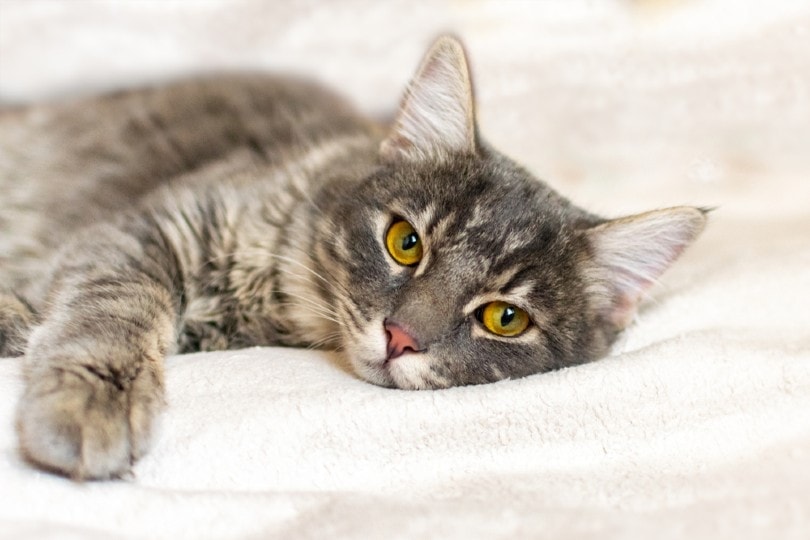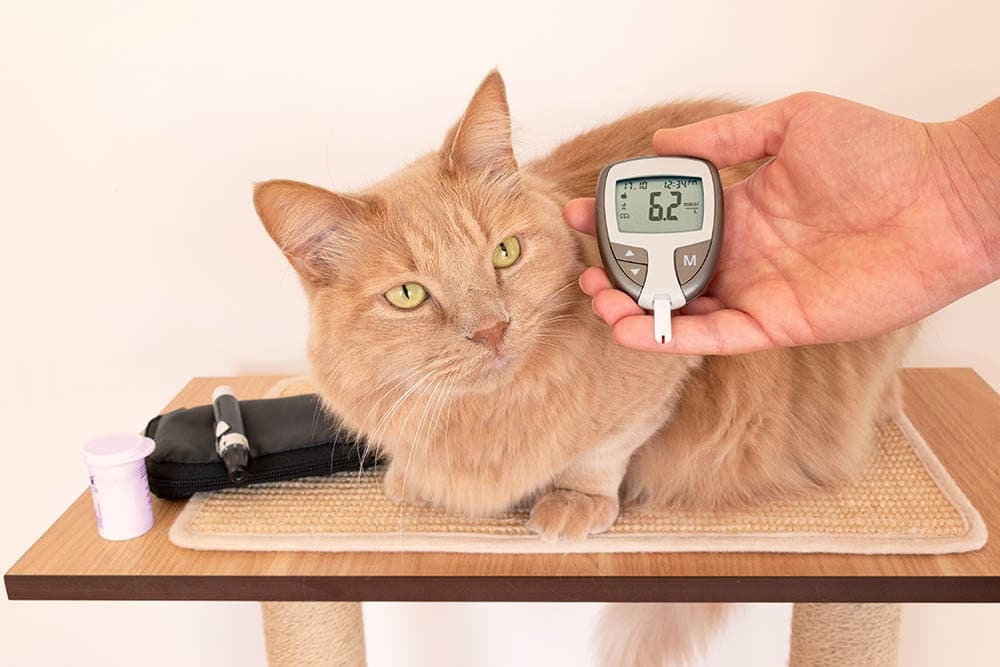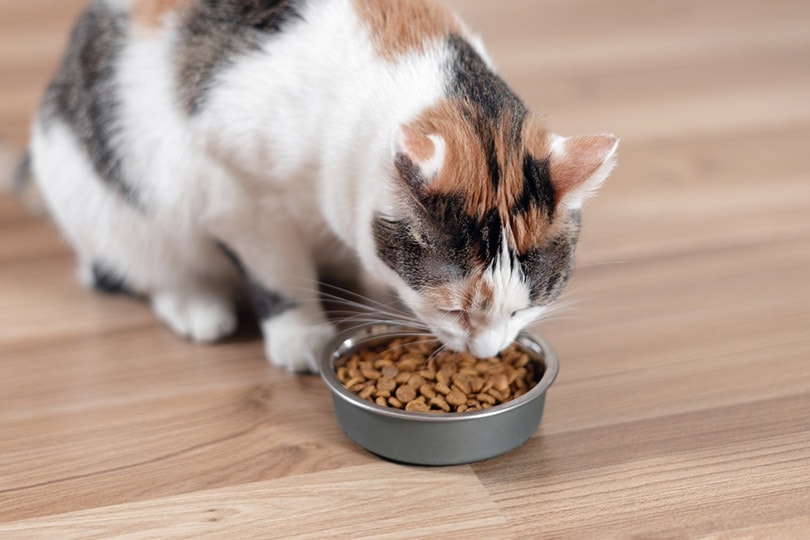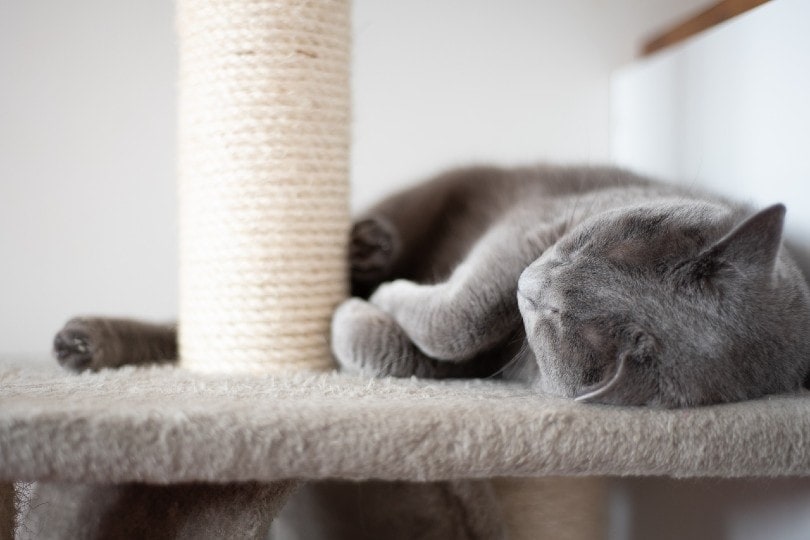Diabetes in Cats: Signs, Causes & Vet Approved Treatments
Updated on

Click to Skip Ahead
In this article, we’ll look closely at the symptoms, the causes, and the best treatment available. While there’s no cure for diabetes, it doesn’t mean a death sentence for your fur baby. It’s possible to manage the symptoms, so let’s take a more in-depth look at this medical condition.
What is Diabetes Mellitus?
Diabetes mellitus is a condition where the pancreas does not properly produce insulin. It may produce very little or none at all. When this happens, your cat’s body cannot balance glucose levels or blood sugar. The disease usually strikes middle-aged to senior cats, and males are more prone to develop diabetes than females. It is a serious condition that can be life-threatening if not treated. If you suspect your cat may have a health issue, then a trip to the vet is in order, especially if they are showing signs of diabetes.

Types of Diabetes
Type I diabetes (insulin-dependent): Often referred to as “juvenile diabetes” or “insulin-dependent” diabetes, type I requires a source of insulin, usually through injections. The destruction of beta cells in the pancreas is irreversible, permanently inhibiting the pancreas from functioning correctly. Type I is typically rare in cats.
Type II diabetes (noninsulin-dependent): Type II is different in that some insulin-producing cells remain; however, the amount produced is insufficient, there is a delayed response in secreting the insulin, or your cat’s tissues are insulin-resistant. Type II is the most commonly seen in cats.
First Signs of Diabetes in Cats
For starters, these four main symptoms are telltale signs your cat may have diabetes.
- Increased thirst
- Increased urination
- Increased appetite
- Weight loss
Generally, these symptoms occur in the early stages of the disease. Increased thirst and urination arise due to high sugar levels in your kitty’s blood. The high levels cause stress on the kidneys, and the kidneys are too overwhelmed to filter out glucose. In this instance, sugar in the blood will “spill out” into the urine, pulling extra water to dilute it and then causing an increased loss of water in the urine resulting in an increased thirst drive.
Increased appetite and weight loss stem from the glucose not breaking down properly, and your cat’s muscles and organs cannot use glucose for energy. As a result, the cat’s metabolism will use fat and muscle for energy requirements causing an increased appetite and weight loss.

Causes of Diabetes in Cats
Several factors play a role in diabetes development.
- Obesity: If your cat is obese but not showing signs of diabetes, it’s wise to bring their weight down to avoid possibly developing the disease. This can be accomplished through a proper diet.
- Physical Inactivity: If your cat has become a lazy bone, there are toys available that will get your cat moving. Toys provide mental stimulation, too. Even if your cat is older, there are toys available to get your senior moving.
- Aging: Diabetes is more common in middle-aged and senior cats. It’s important to take your cat kiddo for yearly examinations.
- Males: Male cats are at greater risk for developing diabetes. Males have lower insulin sensitivity values (37%) compared to females, which can lead to obesity.
- Corticosteroids: Steroid treatment may result in the development of diabetes in pre-diabetic cats. However, diabetes can usually be resolved when the treatment is stopped.
Treatment for Diabetic Cats
Diabetic treatment is a lifelong commitment that will require many interactions with your veterinarian. It may take some time to get your cat’s glucose levels where it needs to be. You can purchase a glucose meter to keep track of their glucose levels. Be sure to purchase a meter specifically for cats because glucose meters for humans will not give accurate results. Your vet can help you decide on a competent monitor.
- At-Home Insulin Therapy
- Medications
- Diet
- Regular checkups
Frequently Asked Questions (FAQ)
What Can I Expect if My Cat Has Diabetes?
If your cat has recently been diagnosed with diabetes, your veterinarian will recommend lifestyle changes for your kitty, and that will include feeding a diabetic cat food.
Many cats on a high carbohydrate diet (like many commercial dry cat foods have) will see great improvement when changing to a species-appropriate low carbohydrate, high in protein, and moderate in fat diet. This is why it is very important to check the food labels and get advice from a professional. Many modern domestic cats suffering from diabetes can reach remission when they are changed to a diet that is appropriate for their metabolism and needs.
It’s imperative to regularly monitor your cat’s blood glucose levels, so glucose meters are a must if your cat has been diagnosed with diabetes. We’ve mentioned that having a diabetic cat is a lifelong commitment, and it’s wise to familiarize yourself with common symptoms. The signs of low blood sugar include lethargy, anxiety, confusion, or weakness. Keep in mind that if the carbohydrate amount of your cat diet’s is reduced, you will most likely have to reduce the amount of insulin as well. Regular glucose level checks and treatment adjustments should become part of the routine.
How Long Do Cats Live After Being Diagnosed With Diabetes?
If your cat has diabetes, the goal is to achieve remission. While there’s no cure, the disease can be managed through the various treatments mentioned above. As long as the disease is controlled, your kitty can live a normal life. Your cat’s lifespan will be cut short if left untreated.
Final Thoughts
No one likes to see their cat sick, especially with an incurable disease. Luckily, there are plenty of treatments available to get your cat feeling healthy while living with diabetes. Remember, it’s not a death sentence, and with constant interaction with your veterinarian, you can manage the disease so your cat can still live its best life.
Featured Image Credit: Ro_ksy, Shutterstock














